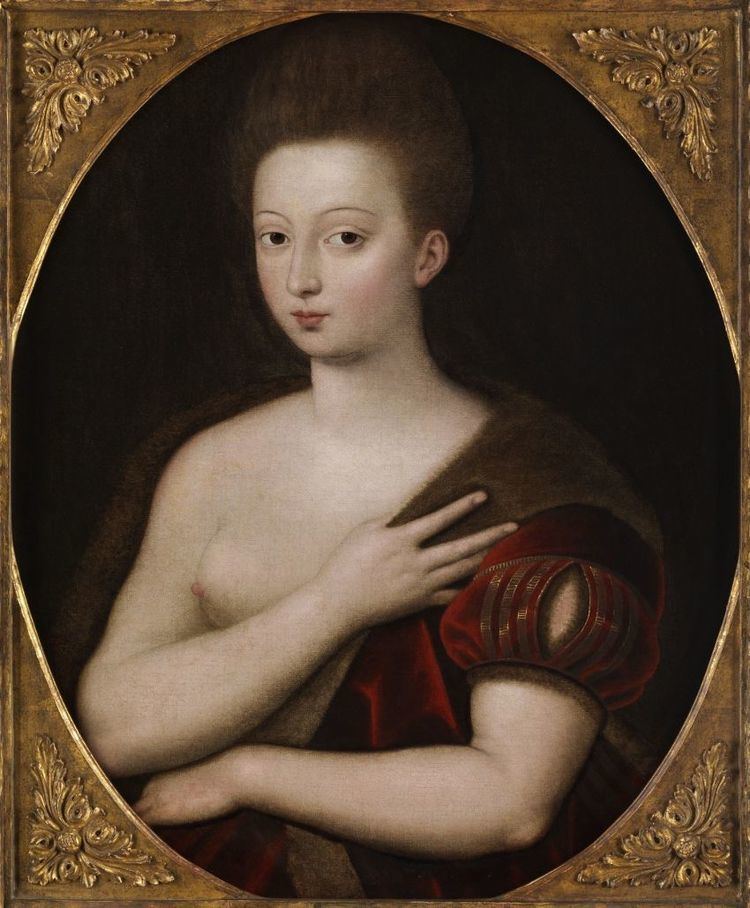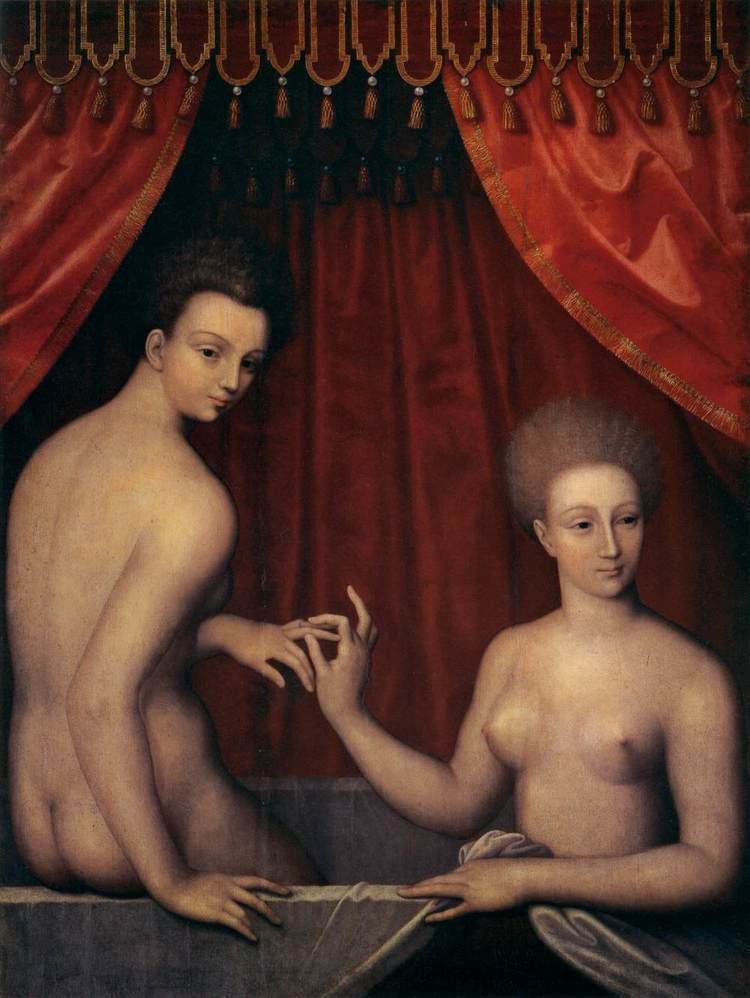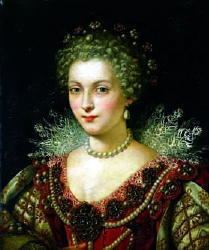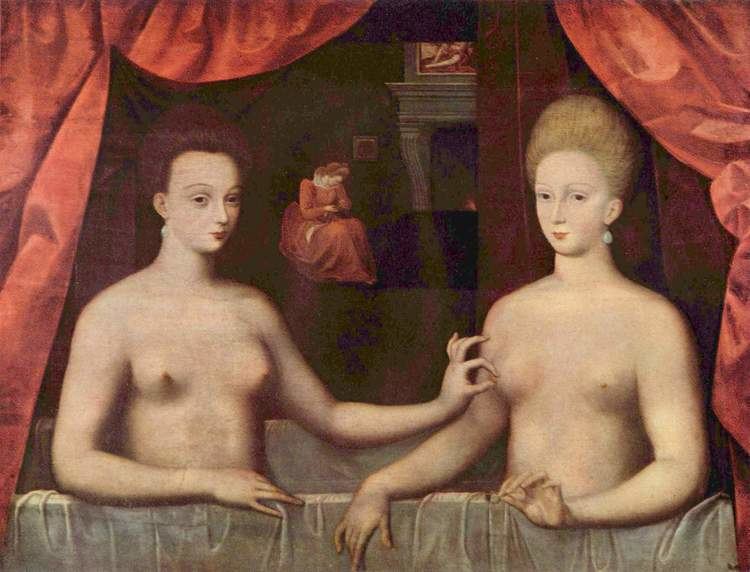 | ||
Children César, Duke of Vendôme, Catherine Henriette de Bourbon Siblings François Annibal d'Estrées Parents Antoine d'Estrées, Françoise Babou de La Bourdaisière Similar Henry IV of France, César - Duke of Vendôme, Marie de' Medici, Catherine Henriette de Balzac, Diane de Poitiers | ||
Gabrielle d'Estrées, Duchess of Beaufort and Verneuil, Marchioness of Monceaux ([ɡabʁiɛl dɛstʁe]; 1573 – 10 April 1599) was a mistress, confidante and adviser of Henry IV of France. She persuaded Henry to renounce Protestantism in favour of Catholicism in 1593. Later she urged French Catholics to accept the Edict of Nantes, which granted certain rights to the Protestants. It was legally impossible for the king to marry her, because he was already married to Margaret of Valois, but he acknowledged Gabrielle as the mother of three of his children, and as "the subject most worthy of our friendship".
Contents
- Gabrielle d estr es et une de ses s urs anonymous
- Birth
- Royal mistress
- Death
- Children
- Representation in art
- References

Gabrielle d estr es et une de ses s urs anonymous
Birth

She was born at either the Château de la Bourdaisière in Montlouis-sur-Loire, in Touraine, or at the château de Cœuvres, in Picardy.
Royal mistress

In November 1590, Henry IV fell in love with Gabrielle d'Estrées. She became one of his many mistresses in the middle of his bitter struggle with the Catholic League. Although he was married to Margaret of Valois, Henry and Gabrielle were openly affectionate with each other in public. Fiercely loyal, Gabrielle accompanied Henry during his campaigns. Even when heavily pregnant, she insisted on living inside his tent near the battlefield, making sure his clothing was clean and that he ate well after a battle, handling the day to day correspondence while he fought. As she was an intelligent and practical woman, Henry confided his secrets to her and followed her advice. When the two were apart, Henry frequently wrote her letters while on his sojourn trips at war camps.

Born a Catholic, Gabrielle knew that the best way to conclude the religious wars was for Henry himself to become a Catholic. Recognizing the wisdom in her argument, on 25 July 1593 Henry declared that "Paris is well worth a Mass" and permanently renounced Protestantism. This enabled him to be crowned King of France on 27 February 1594. Henry also arranged for Gabrielle's marriage to Liancourt to be annulled the same year.

On 7 June 1594, their first child was born, a son, César de Bourbon, future Duke of Vendôme. On 4 January 1595, Henry IV officially recognized and legitimized his son in a text validated by the Parlement de Paris. In that text, he also recognized Gabrielle d'Estrées as the mother of his son and as "the subject the most worthy of our friendship"; in other words, Henry IV had the Parlement de Paris officially ratify Gabrielle's position as his mistress. In 1596, he made her marquise de Monceaux and, the following year, duchesse de Beaufort.
Henry IV also recognized and legitimized two more children he had with Gabrielle: Catherine-Henriette de Bourbon, a daughter born in 1596, and Alexandre de Bourbon, a son born in 1598. The relationship between Henry and Gabrielle did not sit well with some members of the French aristocracy, and malicious pamphlets circulated that blamed the new duchess for many national misfortunes. One of the most vicious nicknames ascribed to Gabrielle was la duchesse d'Ordure ("the Duchess of Filth").
Gabrielle became Henry's most important diplomat, using her female friends amongst the various Catholic League families to bring about peace. In March 1596, Henry gave both Gabrielle and his sister Catherine a set of gold keys which bestowed upon them seats on his council. This gift pleased Gabrielle so much that she took to wearing the little keys on a chain around her neck.
In 1598, Henry issued the Edict of Nantes, which gave the Huguenots certain rights while deferring to Catholics. Joining forces, the Huguenot Catherine and Catholic Gabrielle went to work overriding the objections of powerful Catholics and Huguenots and forcing compliance with the edict. Henry was so impressed with her efforts that he wrote "My mistress has become an orator of unequaled brilliance, so fiercely does she argue the cause of the new Edict."
Death
After applying to Pope Clement VIII for an annulment of his marriage and authority to remarry, in March 1599 Henry gave his mistress his coronation ring. Gabrielle, so sure that the wedding would take place, stated, "Only God or the king's death could put an end to my good luck". A few days later, on 9 April, she suffered an attack of eclampsia and gave birth to a stillborn son. King Henry was at the Château de Fontainebleau when news arrived of her illness. The next day, 10 April 1599, while Henry was on his way to her, she died in Paris.
The King was grief-stricken, especially given the widely held rumor that Gabrielle had been poisoned. He wore black in mourning, something no previous French monarch had done. He gave her the funeral of a queen; her coffin was transported amidst a procession of princes, princesses, and nobles to the Saint-Germain-l'Auxerrois church in Paris, for a requiem mass. Remembered in French history and song as La Belle Gabrielle, she was interred at the Notre-Dame-La-Royale de Maubuisson Abbey in Saint-Ouen-l'Aumône (Val-d'Oise, Île-de-France).
A publication after her death called the Mémoires secrets de Gabrielle d'Estrée (“The Secret Memoirs of Gabrielle d’Estrée”) is believed to have been written by one of her friends.
Children
Her four children by Henry were:
Representation in art
She is the presumed subject of the painting Gabrielle d'Estrées et une de ses sœurs by an unknown artist (c.1594). Gabrielle sits up nude in a bath, holding (presumably) Henry's coronation ring, whilst her sister sits nude beside her and pinches her right nipple. Henry gave Gabrielle the ring as a token of his love shortly before she died. The painting is in the Louvre Museum in Paris.
J. M. W. Turner painted a watercolour of "The Palace of the Fair Gabrielle" at Bougival (private collection, U.S.A.).
